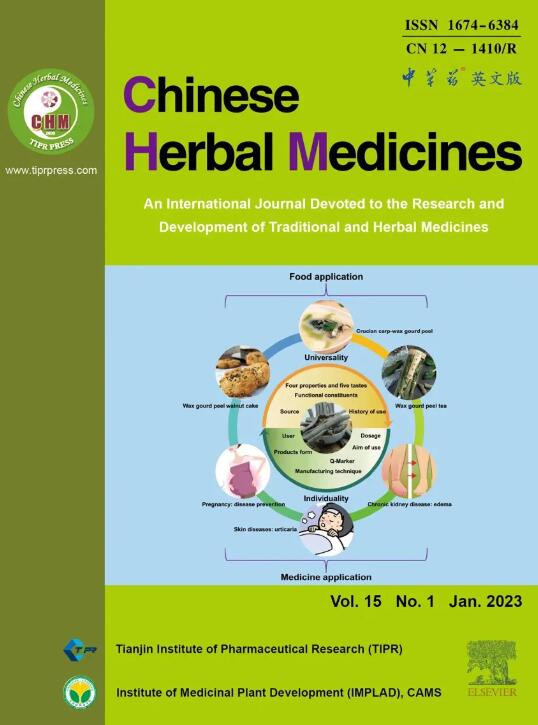基于网络药理学和实验验证的舒风解毒胶囊治疗细菌性肺炎的机制
IF 8.9
4区 医学
Q1 CHEMISTRY, MEDICINAL
引用次数: 0
摘要
方法采用网络药理学方法筛选舒风解毒胶囊的活性化合物和靶基因,建立多耐药铜绿假单胞菌(MDR-PA)小鼠致死模型和MDR-PA肺炎模型,评价舒风解毒胶囊的治疗效果和作用机制。方法采用网络药理学方法筛选SFJD的活性化合物和靶基因,建立多耐药性铜绿假单胞菌(MDR-PA)小鼠致死模型和MDR-PA肺炎模型,评价SFJD的疗效和作用机制。结果经过筛选,产生了172种SFJD的潜在成分,并在此基础上构建了SFJD-成分-靶标-BP相互作用网络。基因本体(GO)和京都基因组百科全书(KEGG)富集显示,SFJD可调控IL-17信号通路和Janus激酶/信号转导和转录激活因子(JAK/STAT)信号通路。分子对接显示,潜在的靶蛋白与主要活性成分有良好的结合。SFJD 能明显降低致死模型的死亡率并延长存活天数。肺指数和肺部病理变化也明显降低。SFJD可明显降低白细胞介素-17A(IL-17A)、TNF受体相关因子6(TRAF6)、核因子-kappa B磷酸化抑制因子(p-IκB)/NF-κB磷酸化抑制因子(IκB)、磷酸化NF-κB p65(p-NF-κB p65)、磷酸化蛋白激酶B(p-AKT)/AKT的表达、转录信号转导和激活因子 3 磷酸化 (p-STAT3)/STAT3、转录信号转导和激活因子 1 磷酸化 (p-STAT1)/STAT1,以及白细胞介素 6 (IL-6)、肿瘤坏死因子 α (TNF-α) 和 IL-1β 的蛋白水平。结论结合网络药理学和体内研究发现,SFJD 通过抑制 IL-17 通路和 JAK/STAT 信号通路对 BP 发挥治疗作用。这项研究为 SFJD 治疗 BP 提供了新的证据。本文章由计算机程序翻译,如有差异,请以英文原文为准。
Mechanisms of Shufeng Jiedu Capsule in treating bacterial pneumonia based on network pharmacology and experimental verification
Objective
The aim of this study was to investigate the underlying mechanism of Shufeng Jiedu Capsule (SFJD) for treating bacterial pneumonia (BP) in vivo based on network pharmacology and experimental verification study.
Methods
Network pharmacology was used to screen the active compounds and target genes of SFJD. Then, the multi drug resistance-Pseudomonas aeruginosa (MDR-PA) mice lethal model and MDR-PA pneumonia model were established to evaluate the therapeutic effects and underlying mechanisms of SFJD. Western blot and ELISA were used to determinate the protein expression level of the IL-17 signaling pathway and JAK/STAT signaling pathway.
Results
After screening, 172 potential components of SFJD were generated, based on which we constructed an SFJD-component-target-BP interaction network. The Gene ontology (GO) and Kyoto encyclopedia of genes and genomes (KEGG) enrichment revealed that SFJD could regulate the IL-17 signaling pathway and Janus kinase/signal transducer and activator of transcription (JAK/STAT) signaling pathway. Molecular docking showed that the potential target proteins had good combinations with the main active components. SFJD significantly reduced the mortality and prolonged survival days in lethal models. The lung index and pathological changes in the lung were also significantly decreased. SFJD could significantly decrease the expression of interleukin-17A (IL-17A), TNF receptor associated factor 6 (TRAF6), phospho-inhibitor of nuclear factor-kappa B (p-IκB)/inhibitor of NF-κB (IκB), phospho-NF-κB p65 (p-NF-κB p65), phospho-protein kinase B (p-AKT)/AKT, phospho-signal transducer and activator of transcription 3 (p-STAT3)/STAT3, phospho-signal transducer and activator of transcription 1 (p-STAT1)/STAT1, and the protein level of interleukin-6 (IL-6), tumor necrosis factor α (TNF-α), and IL-1β.
Conclusion
Combined with network pharmacology and in vivo study, it was found that SFJD exerted its therapeutic effects on BP by inhibiting the IL-17 pathway and JAK/STAT signaling pathway. This study provides new evidence for SFJD in treatment of BP.
求助全文
通过发布文献求助,成功后即可免费获取论文全文。
去求助
来源期刊

Chinese Herbal Medicines
CHEMISTRY, MEDICINAL-
CiteScore
4.40
自引率
5.30%
发文量
629
审稿时长
10 weeks
期刊介绍:
Chinese Herbal Medicines is intended to disseminate the latest developments and research progress in traditional and herbal medical sciences to researchers, practitioners, academics and administrators worldwide in the field of traditional and herbal medicines. The journal's international coverage ensures that research and progress from all regions of the world are widely included.
CHM is a core journal of Chinese science and technology. The journal entered into the ESCI database in 2017, and then was included in PMC, Scopus and other important international search systems. In 2019, CHM was successfully selected for the “China Science and Technology Journal Excellence Action Plan” project, which has markedly improved its international influence and industry popularity. CHM obtained the first impact factor of 3.8 in Journal Citation Reports (JCR) in 2023.
 求助内容:
求助内容: 应助结果提醒方式:
应助结果提醒方式:


